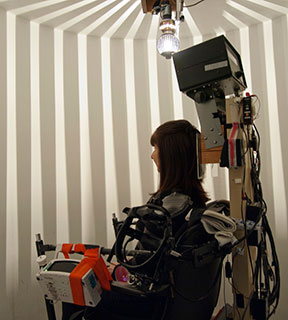By Kirstie Saltsman, Ph.D.
Many of us have experienced the feeling of swaying, rocking, or bobbing after stepping off a boat. But for some people, the sensation, commonly called motion sickness, never goes away. In rare cases, this sensation can persist for months or years, a condition known as Mal de Debarquement Syndrome (MdDS).
While MdDS has been recognized for decades, the cause has been elusive, and there has been no effective way to treat it. Now, drawing insight from earlier work, preliminary findings from a small study by a team of NIDCD-supported researchers are pointing to a promising treatment for MdDS. The findings may also shed light on more common conditions, such as motion sickness or the more typical, short-lived rocking sensation people experience after a cruise or a flight.
Findings from the research, which was led by Mingjia Dai, Ph.D., assistant professor of neurology, and Bernard Cohen, M.D., Morris Bender Professor of Neurology, at the Icahn School of Medicine at Mount Sinai in New York, appeared online in July in the journal Frontiers in Neurology.
MdDs is associated with a number of other problems, such as insomnia, headache, confusion, blurred vision, disorientation, and in some cases, anxiety and depression. The condition can be debilitating. People with the syndrome feel like they are still on the ship after disembarking, with the ground moving beneath their feet and their head rocking. Paradoxically, the only respite comes from riding in a vehicle such as a train or a car, but the relief is temporary, and symptoms return after the ride.
The new, preliminary findings are based on decades-old experiments by space flight scientists. In a study published in 1962, researchers placed volunteers in a room that rotated slowly, then asked them to move their heads from side to side. The study volunteers developed unusual patterns of eye movements. The results struck Dr. Dai and his colleagues because these types of eye movements are a hallmark of MdDS.
A subsequent study in monkeys supported the results of the space flight experiments and pointed to a disturbance of the vestibulo-ocular reflex (VOR) as the cause of the eye movements. The VOR is a natural process by which your eyes compensate for head movements, keeping the image from wobbling while maintaining your spatial orientation. Without the VOR, you would have difficulty reading print when your head is moving and trouble with balance and walking.
From these earlier experiments, Dr. Dai suspected that MdDS was rooted in a maladapted VOR: when at sea, the VOR adapts to the new pattern of motion, but upon return to dry land it fails to realign itself. If his hypothesis was correct, then it might be possible to readapt the VOR by treating patients with an opposing set of visual cues and pattern of motion: just as you straighten the course of a car that has drifted to the left by turning the wheel to the right, this strategy could potentially cancel out the misaligned components of the VOR and alleviate symptoms.

People with a severe balance disorder, Mal de Debarquement Syndrome, achieved remission by viewing a moving pattern of stripes while slowly rocking their head from side to side.
Credit: Mingjia Dai, Ph.D., Icahn School of Medicine at Mt. Sinai
To test the idea, the researchers observed volunteers who had MdDS as they watched a moving pattern of black and white stripes projected on the wall of a small circular room, while they slowly rolled their heads from side to side. The direction of motion of the stripes and the speed of the head movements were based on the direction and speed of rocking, swaying, or bobbing felt by each individual patient.
In most cases, one to eight sessions per day for about a week were sufficient to benefit from the treatment. Of 24 participants (21 women, three men, mean age 43.3 years), 17 recovered completely or improved substantially, with a mean follow-up of approximately one year after treatment. Six responded well initially but their symptoms returned, and one participant received no benefit. Side effects of the treatment were negligible.
The researchers concluded that maladaptation of the VOR was responsible for producing MdDS and that individualized patterns of visual stimuli and head movements can readapt it.
“MdDS affects every aspect of people’s lives,” says Dr. Dai. “Now we finally have more than a name for this devastating condition—we have a treatment that could potentially help hundreds of Americans affected by MdDS.”
The research team is continuing to refine the therapeutic approach, with the goal of achieving remission in a greater proportion of patients. They are also working to test the new method on people with other types of MdDS, such as spontaneous MdDS, a form of the syndrome that appears without prior travel on the sea.
“Many questions remain to be answered,” says Dr. Cohen. “We still don’t understand why MdDS affects more women than men, why symptoms are temporarily relieved by traveling in a vehicle, or which neural networks in the brain are responsible for the illusory sensation of motion.”
This work was supported by the NIDCD [grants R21 DC012162 (Mingjia Dai); R01 DC012573 and P30 DC05204 (Bernard Cohen)].

